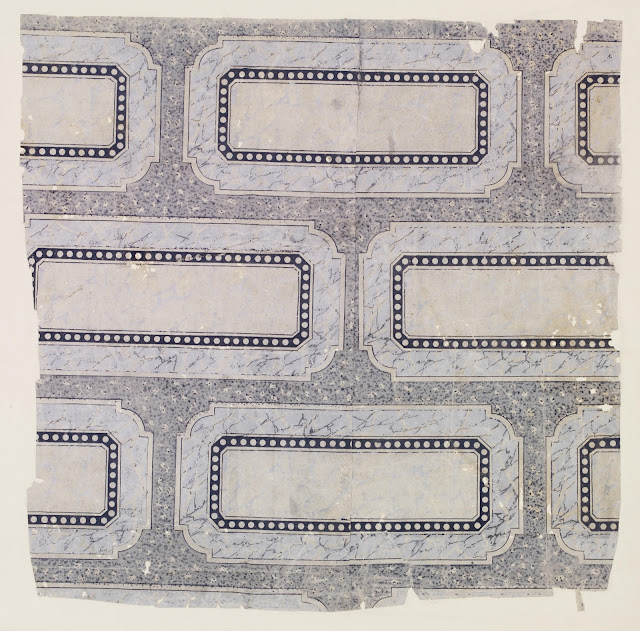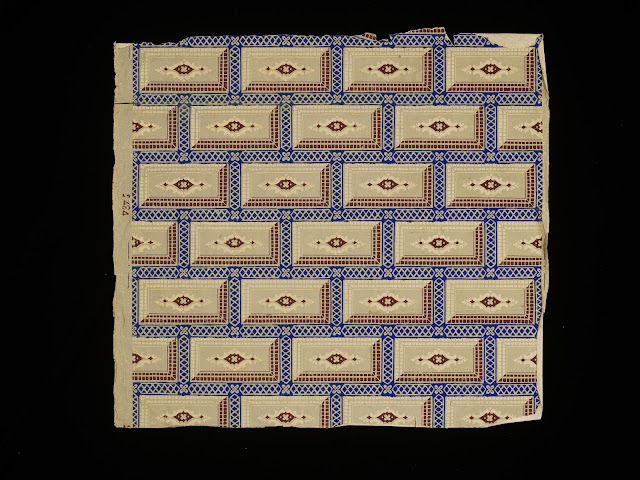 |
| Anonymous English designer Gothic Architecture ca. 1820 block-printed wallpaper Victoria & Albert Museum, London |
"Wallpapers illustrating elements of Gothic architecture were popular in the early 19th century. This one was hung in the Ostrich Hotel at Castle Acre near Swaffham, Norfolk, around 1820. It might have been chosen for its relevance to local sights and scenes. Castle Acre contained a number of ruinous Gothic buildings, notably the Priory church, for which it was well known. At a time when tourists were often interested in ruins and antiquities, a Gothic wallpaper would have been an apt choice of decoration for a hotel. In 1841 the architect and designer A.W.N. Pugin wrote dismissively of 'What are commonly termed Gothic pattern papers for hanging on walls, where a wretched caricature of a pointed building is repeated from skirting to cornice, door over pinnacle and pinnacle over door'. He noted that there was 'a great variety of these miserable patterns', and that the style was 'a great favourite with hotel and tavern keepers'."
– curator's notes from the Victorian & Albert Museum
 |
| Anonymous English designer Imitation Marble Panels ca. 1830-40 block-printed wallpaper Victoria & Albert Museum, London |
 |
| Anonymous English designer Imitation Moulded Plaster-work ca. 1830 block-printed wallpaper Victoria & Albert Museum, London |
 |
| Anonymous English designer Imitation Tile-work ca. 1850 block-printed wallpaper Victoria & Albert Museum, London |
 |
| Anonymous English designer Cornices with Classical Mountings ca. 1825-50 block-printed wallpaper Victoria & Albert Museum, London |
 |
| Cowtan & Son Trompe l'oeil Stonework and Swags ca. 1840 block-printed wallpaper border Victoria & Albert Museum, London |
 |
| Arthur Sanderson & Sons Trompe l'oeil Moulding ca. 1840-70 block-printed wallpaper border Victoria & Albert Museum, London |
 |
| Potters of Darwen, Lancashire Perspective Views of Railway Station ca. 1853 block-printed wallpaper Victoria & Albert Museum, London |
"In the 1850s wallpapers with pictorial patterns seem to have been very popular and were sold in large quantities. However, art educators such as Richard Redgrave and Henry Cole considered such papers to be examples of bad design because they gave the illusion of three dimensions on a flat wall surface. But despite these faults there were some critics, such as a writer in the trade journal The Builder (1851), who believed that pictorial wallpapers were suitable for 'the houses of the humbler classes of society', especially if the subject depicted was educational. Most papers of this kind have not survived, but it is likely that they were used to decorate social spaces such as railway station waiting rooms, cheap hotels or public bars."
– curator's notes from the Victorian & Albert Museum
 |
| Anonymous English designer Gothic Revival design with Landscape Vignettes ca. 1840-50 block-printed wallpaper Cooper Hewitt, Smithsonian Design Museum, New York |
 |
| Anonymous English designer Views of the International Exhibition of 1862, London ca. 1862 block-printed-wallpaper Victoria & Albert Museum, London |
 |
| Walter Crane for Jeffrey & Co. Frieze with Caryatids for Alcestis Pattern Wallpaper 1876 block-printed wallpaper Victoria & Albert Museum, London |
 |
| Walter Crane for Jeffrey & Co. Frieze with Caryatids for Alcestis Pattern Wallpaper 1876 block-printed wallpaper Victoria & Albert Museum, London |
 |
| Walter Crane for Jeffrey & Co. Frieze with Caryatids for Alcestis Pattern Wallpaper 1876 block-printed wallpaper Victoria & Albert Museum, London |
 |
| Walter Crane for Jeffrey & Co. Frieze with Caryatids for Alcestis Pattern Wallpaper 1876 block-printed wallpaper Victoria & Albert Museum, London |